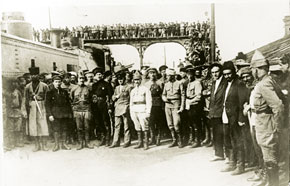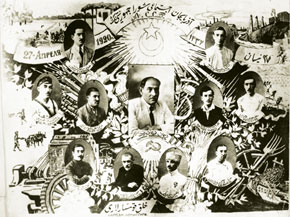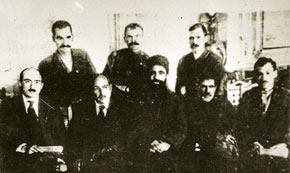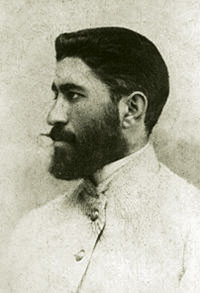How Azerbaijan Offered Part of its Land to Armenia
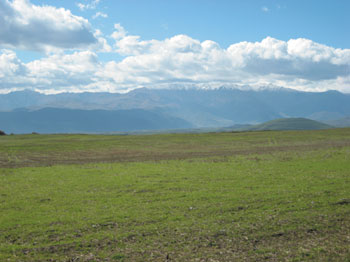 Pages 70-78
Pages 70-78
by Dr. Ismail Musayev
The region of Zangezur, bordering Iran, was given by Azerbaijan to Armenia in turbulent 1920. In his first article published in the last issue of Visions, Dr Ismail Musayev, Professor of Diplomacy at Baku State University, looked at the circumstances that led Azerbaijan to give Zangezur away. Militants from the Armenian Revolutionary Federation, the Dashnaks, were fighting against Soviet forces in Armenia. The Soviet authorities wanted to reinforce the establishment of Soviet power in Armenia and this led to a statement by Azerbaijan´s Soviet leader, Nariman Narimanov, on 1 December 1920 that Zangezur was an integral part of Soviet Armenia. In the second of his two articles, Dr Musayev looks at the events that followed Narimanov´s statement.
Having received the consent and ´blessing´ of the Azerbaijani leadership in their 1 December Statement, the Armenians speeded up their attempts to unite Zangezur to Armenia. They applied their ´own means´ to bribe the Muslim population of the region. An Appeal to the Muslim Population of Zangezur by the Armenian Peasant Council (Shura) on 8 December 1920 is interesting from this viewpoint. The appeal appears to repeat Armenian General Andranik´s appeal of late 1918. It dealt with the historical friendship between Armenians and Azerbaijanis and the absence of hostility between them. The appeal said that the two peoples would live in their common country together and emphasized that Armenians who made attempts on Muslim lives and property would receive appropriate punishment, which meant the death penalty.
 Pages 70-78
Pages 70-78 by Dr. Ismail Musayev
The region of Zangezur, bordering Iran, was given by Azerbaijan to Armenia in turbulent 1920. In his first article published in the last issue of Visions, Dr Ismail Musayev, Professor of Diplomacy at Baku State University, looked at the circumstances that led Azerbaijan to give Zangezur away. Militants from the Armenian Revolutionary Federation, the Dashnaks, were fighting against Soviet forces in Armenia. The Soviet authorities wanted to reinforce the establishment of Soviet power in Armenia and this led to a statement by Azerbaijan´s Soviet leader, Nariman Narimanov, on 1 December 1920 that Zangezur was an integral part of Soviet Armenia. In the second of his two articles, Dr Musayev looks at the events that followed Narimanov´s statement.
Having received the consent and ´blessing´ of the Azerbaijani leadership in their 1 December Statement, the Armenians speeded up their attempts to unite Zangezur to Armenia. They applied their ´own means´ to bribe the Muslim population of the region. An Appeal to the Muslim Population of Zangezur by the Armenian Peasant Council (Shura) on 8 December 1920 is interesting from this viewpoint. The appeal appears to repeat Armenian General Andranik´s appeal of late 1918. It dealt with the historical friendship between Armenians and Azerbaijanis and the absence of hostility between them. The appeal said that the two peoples would live in their common country together and emphasized that Armenians who made attempts on Muslim lives and property would receive appropriate punishment, which meant the death penalty.
Dashnaks take part of Zangezur
The Dashnaks took part of the region and to reinforce their position set up puppet structures at the Tatev ´congress´ (they called it a regional Armenian ´congress´ and not a party congress) such as the Independent Sunik Government on 25 December 1920 and the Armenian Rescue Committee in March 1921. The Armenians were looking to strengthen their military and political positions in the region.
An article headline The Last Fraud of the Dashnaksutun Party, published in Kommunist newspaper in Irevan on 21 January 1921, stated that the Dashnaks had turned unfortunate Zangezur into their own marketplace; various supporters of (Armenian military commander - Ed.) Njdeh and others had gathered there and established relations with the British through Tabriz and Tiflis and were promising them comprehensive assistance.
At the second ´congress´ of Armenians of the region held by the Dashnaks on 26 April 1921 in Tatev, the ´Sunik Government´ was turned into the ´Mountainous Armenian Government´ (or ´New Armenian Government´) which was led by Njdeh. Njdeh moved his headquarters urgently from Goris to Tatev and tried to establish relations with Iranian Armenians and through them with the British. Simeon Vratsyan, who was dubbed the 10-Day Prime Minister, played a special role in this. (He took the office of prime minister after A. Ohanjanyan resigned on 23 November 1920 and served until 2 December the same year.)
However, the Armenian media wrote (in the article Zangezur Fraud and Armenia published in Karmir Astkh newspaper) that although the Armenians who had settled in Tabriz with Simeon Vratsyan at their head had been able to establish close relations with the British, they were avoiding offering any real assistance but were promising a great deal. The article says that according to information of the intelligence service of the Russian Army´s Caucasus Command of 12 April 1921, Armenians in Tabriz and Tehran, led by their bishop, were helping Zangezur and supplying Zangezur (this refers to the Dashnaks - Ismail Musayev) and the Iranian khans in order to delay the Red Army attack. An order to the troops of the Karabakh-Zangezur group of the 11th Army states: ´Njdeh has relations with the Entente through Iran and is defending its authority through it.´ But Iran denied this. The Iranian consul sent a protest letter both to the editorial board of Kommunist newspaper and the People´s Foreign Affairs Committee of the Azerbaijan SSR (letter No 2069, 9 August 1921) over an article published in the 159/362 issue of the newspaper. According to a telegram from Goris, the article stated that Dashnaks had gathered in Tabriz and were trying to influence the Entente through Iran. The Iranian consul wrote that there were only unfortunate Armenian refugees (?! - I.M.) in Tabriz. He referred to information from the governor general of South Azerbaijan and covered up his government´s assistance to the Dashnaks by couching it in ´humanitarian´ terms.
Red army and Soviet Yerevan fight dashnaks for Zangezur
In this instance official Yerevan and the 11th Army Command united their efforts to complete the transfer of Upper Zangezur to Armenia. In May 1921 the Armenian People´s Commissars Council and the 11th Army Command began negotiations through a special delegation with the ´Mountainous Armenian Government´ on the transfer of Zangezur to Armenia without any military action. The negotiations were ineffective. Taking a firm position on Upper Zangezur, Armenians began to prepare various plans and made several political and diplomatic moves. One such move was the ´Agarak Congress´ held on 7 April 1921 with the participation of Muslim representatives who were invited by commander Njdeh himself. At this congress the Dashnaks tried to draw Azerbaijanis to their side under the guise of the struggle against Soviet rule and in this way to subordinate the rest of the region.
Although the transfer of Zangezur was officially proclaimed by the Azerbaijani ´leadership´ (actually Russia), the region was not passed to Armenian subordination immediately. Even in 1921 when the draft of the Azerbaijan SSR´s administrative divisions was prepared, some proposals were made on Zangezur too. On 12 January 1921 the Central Committee of the Azerbaijani Communist (Bolshevik) Party passed a decision to establish a Muslim part of Zangezur. As the explanatory section of the Azerbaijan SSR´s administrative division draft shows, the proposal was made to divide Zangezur into two – the western part that was to be called Zangezur Qazasi (Region) and the eastern part that was to be called Kurdistan because of ´the majority population of Kurdish people´. The division was explained by the natural geography of the region and the difficulty, even impossibility, of ruling the region from the centre. The new division was to help establish a new society. Each part was to have fields, pastures, and forests and the division would strengthen the solidarity of the nation that would consist of Armenians and Muslims.
The proposal certainly contained some contentious points and was actually aimed at the complete transfer of the region to the Armenians step-by-step. The administrative division of the region, part of which was under the control of Armenian armed groups, would help to break it away completely from Azerbaijan. The position of Zangezur in the administrative division was comprehensively discussed on 12, 14 and 24 March and 2 April 1921 at meetings of the Inter-Departmental Commission of the Azerbaijani Revolutionary Committee which had been formed to prepare the new administrative and economic division of the Azerbaijan SSR. The commission was chaired by Gikalo. After much discussion, the protests of Vakilov, Shimankovskiy and Hajiyev against Zangezur´s division into two parts were accepted. The commission decided to keep the previous borders of the region without any change. The description of the internal-administrative division of the Azerbaijan SSR, which was drawn up according to the commission´s protocols, also confirmed the previous borders of the Zangezur region.
Discussions of the problems of the ´Zangezur region´ at the joint meeting of the political and organizational bureaus of the Central Committee of the Azerbaijani Communist (Bolshevik) Party on 13 April 1921 led to a decision to send a commission to the region; the members of the commission were L. Mirzoyan, Ch. Ildirim and others. A. Shirvani resigned as commissar of Zangezur on 12 January 1921 because of the tough situation and difficult environment in the region. After a long delay M. Mahmudbayov was appointed emergency commissar to the Zangezur region on 13 April 1921.
Dashnaks flee to Iran
In early summer 1921, Armenian pressure brought the situation to crisis point in the Aran (Lowland) Zangezur, Qubadli and other territories. From the other side, the Karabakh, Zangezur and Irevan groupings of the 11th Army conducted a joint military operation to take the whole of Zangezur on 16 August 1921. The remnants of the Dashnak group fled to Iran. And thus the transfer of (the western or mountainous) part of Zangezur to Armenia was completed. On 20 June 1921 a new territorial division of Armenia was approved by the People´s Commissars Council. Eight qazas (regions) were established and the ninth region - Zangezur qaza – was soon formed. Zangezur was not included in the 19 May 1921 decree of the Azerbaijani Revolutionary Committee on a census of the population of the Azerbaijan SSR. By 1922 Zangezur was not mentioned in the information of the Azerbaijani Police Chief either. The Russian-Armenian plan that had been in preparation for a long time had been finally realized; they had got part of Azerbaijani territory – Upper Zangezur.
Conflict between dashnaks and Soviets a pretext to take Azerbaijani land
Analysis of the processes shows once more that the internal Armenian Dashnak versus Communist struggle as well as the latter events in Zangezur (Armenians presented them as civil war) had no serious foundation and were aimed only at taking ownership of Azerbaijan´s land and served as an ideological cover for events.
This is admitted by Armenian leaders and in articles in the Armenian media. The bulletin of the media and information department of the Russian Soviet Federal Socialist Republic´s plenipotentiary representation to Iran contains a very interesting fact. The bulletin gives a review of the country´s media based on report No 53 of the Iranian information bureau from 5 November 1921. The review included a letter from M. Petrosyan, a well-known member of the Dashnak Party, to the ´Prime Minister´ Simeon Vratsyan which was printed in the Zang newspaper (13 October 1921, issue No 14). In the letter Simeon Vratsyan advised Dashnaks from Tabriz to join forces with Soviet Armenia and not to hamper the processes under way.
Later, in the 13 November 1921 issue of Hayk newspaper, published in Tabriz, a former commander of one of the volunteer groups in Zangezur, E. Avdamyan, criticized ´Prime Minister´ Simeon Vratsyan for releasing many prominent Bolsheviks from prison when he was in office in Irevan and accused some members of the Dashnak government of hiding Bolsheviks, including Dovletyan and even the chairman of the Armenian Revolutionary Committee, S. Kasyan, in their homes. Archive documents reveal: ´Most Armenian communists wear a mask of communism. When the mask is thrown off, an Armenian communist is a Dashnak and dreams of Great Armenia.´ Ov. Kachaznuni shared this opinion: ´The Dashnaksutyun is no longer strong and effective for Armenian political independence and has to be replaced by Armenian Bolsheviks. They can continue the process now and they are already doing it.´ Ov. Kachaznuni pinned his hopes on the Red Army and Russia and wrote: ´When the Red Army leaves the South Caucasus, we will be
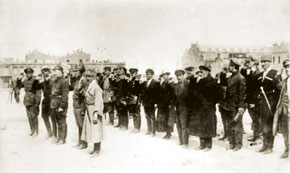 Review of the units of the 11th Army. Members of the Azerbaijan Revolutionary Committee: T. Smilga (third in the first row), second row left to right: G. K .Ordjonikidze, Ch. Ildirim, M. K. Levondovski, S. M. Kirov, F. Shlemova
Review of the units of the 11th Army. Members of the Azerbaijan Revolutionary Committee: T. Smilga (third in the first row), second row left to right: G. K .Ordjonikidze, Ch. Ildirim, M. K. Levondovski, S. M. Kirov, F. Shlemova The 17th protocol of the joint meeting of the Political and Organizational Bureau of the Azerbaijani Communist (Bolshevik) Party on 12 January 1921 confirms the aforementioned view: the Dashnaks are active in Zangezur and at the same time have joined the Communist Party and taken high office in Armenia.
Narimanov wrote in his article A View of the Occupation of the Caucasus (February 1919): ´The Dashnaks have shown throughout their 30 years of political life that they are ready to accept any colour and wear any mask to realize their dreams of Great Armenia… If Soviet rule is established in the Caucasus, the Dashnaks will instantly change their masks and become Communists and lead affairs in Azerbaijan and Georgia.´ These opinions were soon justified.
Whole of upper Zangezur transferred to Armenia
The Armenians tried to achieve the total transfer of Zangezur, its lower and eastern parts, to Armenia and with this aim in mind crudely meddled in its internal affairs. A. Qarayev´s telegram to Nariman Narimanov and M. Huseynov on 23 July 1921 states that the representative of Soviet Armenia to the region, Ter Simonyan, had declared in his order in Goris the transfer of the mountainous part of Karabakh to Armenia, too. As the telegram shows, this was a diversion and ended in another political game; Ter Simonyan tried his best to achieve the transfer of Lower Zangezur to Armenia. Many problems were made, various intrigues were created and the transfer of Eastern Zangezur was demanded.
In a situation of continuing Dashnak-Communist aggression the Azerbaijani government sent a telegram to the Armenian government on patching up their mutual relations in July 1921. The ´leaders´ of the Azerbaijan SSR focused on solving the problem with the Sultanovs (Khosrov Bay Sultanov was governor-general of Karabakh - Ed). Armenian sabotage played a significant role in this; the Armenians spread a rumour that Sultan Sultanov was reviving relations with the Dashnaks in the Shusha qaza (region) together with Njdeh to fight against the 11th Army. However, there is no mention of this in the archives or other resources. The Armenians knew the class prejudice of the Soviet authorities against the Sultanovs and bore this in mind when devising their sabotage. For this and other reasons the Soviet authorities exacted punishment on the Sultanovs. (They soon left the country for Turkey and continued their struggle for Azerbaijan abroad.)
Armenian government pushes Azerbaijanis out of Zangezur
As a result of all this, the upper part of Zangezur (Qafan, Goris etc. – about 4505.5 sq.km. of land) was given to Armenia totally in late 1921. The Armenian government did not implement the agreements on the return of refugees to their native land and, on the contrary, forced Azerbaijanis out of the region. The decision ´On refugees´, signed by the chairman of the Armenian Revolutionary Committee, S. Kasyan, and others is especially interesting in this respect. The decision that was made in the first half of 1921 was another step towards the ´ethnic cleansing´ of Azerbaijanis from several territories and the ´deturkification´ of these lands; Azerbaijani refugees were prevented from returning to their historical lands.
The decision stated that the following is considered important, bearing in mind the great influx of refugees to Armenia (this implies the Azerbaijanis who have left their land - I.M.), the overloading of several regions of Armenia because of the influx of refugees from several territories (Turkey is implied - I.M.) and the critical situation in food, housing and transport in the country: 1. The Soviet reigns of the Northern Caucasus and Azerbaijan and Nakhchivan Revolutionary Committee should be asked to stop the flow of refugees to Armenia until the food, transport and housing problems can be solved.
2. All the border troops should be ordered not to let refugees into Armenia. The Armenian government sent a telegram to the Azerbaijani People´s Commissariat of Foreign Affairs on 16 November 1921 (telegram No 8165): Taking into account the very tough economic and food situation in Zangezur, we ask that the influx of Muslim refugees to the region be stopped until a change in the situation.
The Armenian leadership and diaspora tried to accommodate Armenians in various countries as well as in the territories that had been given to Armenians in Azerbaijan under such pretexts. An official report in Nor Ashkhator newspaper (15 August 1920, issue No 106) says that the government sent a report to the Armenian patriarch in Constantinople to organize the removal of Armenians from Turkey, Bulgaria and Romania to Armenia (in fact to Azerbaijan - I.M.). The Pravda Gruzii newspaper also published some interesting material: the Armenian People´s Commissariat of Foreign Affairs told the British Foreign Office to send the Armenians in Mesopotamia to Batumi from where they could leave for Armenia if the British government was unable to assist them.
The representative of the Russian Soviet Federative Socialist Republic in Iran, Rotshteyn, and the archbishop made speeches at the launch of the representation of the Armenian SSR in Tehran. They thanked Russia for the independence of Armenia and 7,000 Armenians participating in the event stated their wish to become citizens of Armenia. According to the Iranian media, especially to the article headlined Armenian Refugees published in Iran newspaper on 25 November 1921 (report No 66), the Armenian Catholicos of Egypt asked via the Persian consul the Iranian government to help Armenian refugees return to the country (Armenia - I.M.). In reply, the prime minister stated that the refugees were being offered proper help.
As the accommodation of the Armenians in Upper Zangezur led to the Azerbaijanis being forced out under various pretexts, the Azerbaijani government was asked at the second congress of Azerbaijani Soviets in April 1922: ´The government has been informed that the civilian population of the Zangezur region is being forced out by arms and would like to know what is being done in this regard.´ In addition, this information was sent to the Central Executive Committee of the Azerbaijan SSR and an inquiry was sent to the Armenian government.
Armenia seeks to gain whole of Zangezur
Later, the Armenians tried in various ways to get the rest of Zangezur too. The interstate border was defined in favour of Armenia at the meetings of the Presidium of the Transcaucasus Executive Committee: according to Article 5 of the Second Protocol of the Presidium on 1 January 1927, 24 villages in Mehri-Jabrayil regions, and according to Article 1 of the 18th Protocol on 20 April 1927, 1,065 dessiatina (2,876 acres - Ed.) of land in Zangezur-Kurdistan regions were given to Armenia. Another meeting of the Presidium chaired by M. Skhakay, which was attended by the representatives of the Azerbaijan SSR M. Bagirov, D. Bunyadzade and others, on 18 February 1929 gave three villages of Zangilan (Nuvadi, Elnazir and Tughut) to Armenia to ´form a new region in Mehri´ (Protocol 3). The Zangilan leaders ´justified´ this by referring to the long distance between the villages and the region´s centre and the difficulty of maintaining links with them, etc. Mehri District was formed when Nuvadi, Aldara, Lahvaz, Astazur and other settlements were given to Armenia in 1929-31.
The Presidium of the Central Executive Committee of the Transcaucasus Soviets on 18 February 1929 (Article 3, Protocol 3) gave 657 sq.km. of Nakhchivan region (three villages in Sharur, six in Shahbuz, and Mehri and Mugaker settlements in Qarchiyan soviet of Ordubad qaza and one part of Kilit) to Armenia, while paying no regard to the position of Turkey which was a party to the Kars Treaty. A decision of another meeting of the Presidium on 5 March 1938 gave some territories surrounding Sadarak and Karki villages in Sharur region to Armenia. The decision was signed by the chair of the nationalities department of the Central Executive Committee, Isakhanyan, and the chair of the Department of Works, Gadagchyan, as the ´representatives´ of Azerbaijan.
In this way, Azerbaijan was separated from its territory of Nakhchivan when the south-western part of Zangezur was given to Armenia and Mehri District was formed in this territory. North Azerbaijan was torn into pieces, its link with Turkey was broken and the ground was prepared for further occupation.
Literature
K istorii obrozovaniya Nagorno Karabakhskoy Avtonomnoy Oblasti Azerbaydzanskoy SSR, 1918-1925 (On the history of the formation of the Mountainous Karabakh Autonomous Region of the Azerbaijan SSR). Documents and materials, Baku, 1989
Archive of Political Parties and Public Movement of the Republic of Azerbaijan Kommunist newspaper, 2 December 1920
Bakinskiy rabochiy (Baku Worker) newspaper, 3 December 1920
Konflikt v Nagornom Karabakhe (Conflict in Mountainous Karabakh) collection of articles, Baku, 1990
Stalin, Eserleri (Works), Baku 1947
Ordzhonikidze, Stati i rechi (Articles and Speeches), Vol. 1, Moscow, 1956
Pravda newspaper, 4 December 1920
M.A. Rasulzada, Azerbaycan Cumhuriyyati (The Azerbaijan Republic), Baku 1990
M.B. Mammadzada, Milli Azerbaycan harakati (The Azerbaijan National Movement), Baku, 1990 Mezhdunarodnaya politika noveyshego vremeni v dogovorakh, notakh i deklarasiyakh (The Latest International Policy in Agreements, Notes, and Declarations), part III, issue I, Moscow, 1928 Central State Archive of the Republic of Azerbaijan
Sobraniye dekretov i prikazov SSR Armenii (Collected decrees and orders of the Armenian SSR), issue No 2, Yerevan, 1923
Dekreti Azrevkoma (Decrees of the Azerbaijan Revolutionary Committee), Baku, 1988
Vtoroy Vseazerbaydjanskiy syezd sovetov. Stenoqraficheskiy otchet, (Second Pan-Azerbaijani Congress of Soviets. Stenographic report), Baku, 1922
